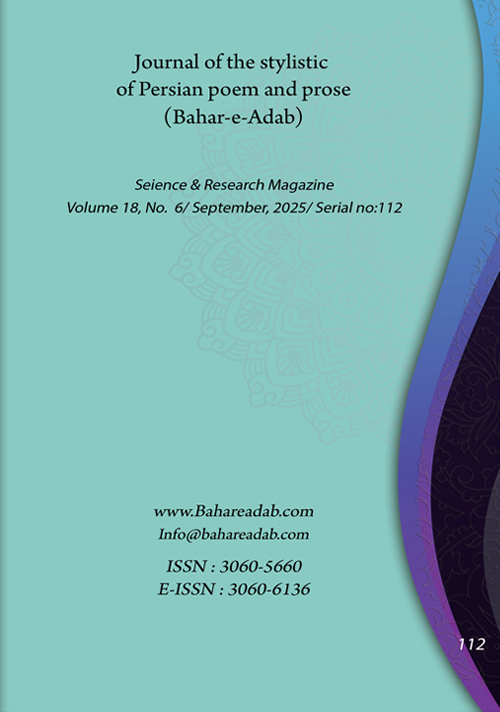- Count View : 43
- آدرس کوتاه شده مقاله: https://bahareadab.com/article_id/1873
- کد doi مقاله: Doi: 10.22034/bahareadab.2025 .18 .7845
Journal of the stylistic of Persian poem and prose
volume Number 18،
number In Volume 6،
،
issue Number 112
Study and Analysis of the Semantic Functions of the Story of Prophet Moses in the Divan of Sanai.
Gholam Mohammad Ghavi , Habib Jadid-ol-Islami Ghale-no (Author in Charge), Behrouz Rumiani
Abstract
BACKGROUND AND OBJECTIVES: Prophet Moses Kalimullah is one of the prophets of the Children of Israel whose life and prophethood, as one of the most detailed Quranic stories, has had a wide appearance in the mirror of Persian poetry and has inspired many poets. The main objective of this article is to analyze and study the semantic functions of the story of Prophet Moses in the Divan of Sanai.
METHODOLOGY: The research in this article is descriptive-analytical based on library studies and the document research method in which we will discuss and study the Quranic story of Prophet Moses in the Divan of Sanai.The examples will be presented selectively and systematically and based on the capacity and volume of the article.
FINDINGS: The influence of Quranic culture in the realm of the Persian language caused poets and mystics to deeply utilize these themes, opening new horizons in the field of Persian literature. Meanwhile, the story of the prophets, including the story of the life and prophethood of Prophet Moses (AS), is among the most important and delightful themes of interest in Persian poetry and Sanai"s poetry due to its special function in the Holy Quran. The findings of the research show that Sanai has used this story for deep and precise educational and mystical purposes.
CONCLUSION: The results of the research indicate that Sanai, while remaining faithful to the principle of the Quranic narrative in the story of Prophet Moses, has used the semantic expansion of this story for a multi-layered reading in order to pay attention to mystical, educational, romantic and lyrical points, to pay attention to the relationship between the disciple and the desired one, and to fight against the ego, arrogance and conceit as inherent characteristics of the ego.
Keyword
Quran. Story of Prophet Moses. Mysticism. Divan of Sanai.
- The Holy Quran. Translated by Mehdi Elahi Qomshehi.
- Algoneh Junqani. Masoud (2014). "Sana'i's Approach to Dualistic Contrasts". Quarterly Mystical Studies, Kashan University. Issue 19. pp. 54-29.
- Bazargan. Abdol Ali (1995). The Order of the Quran. 4 vols. Tehran: Qalam, p. 359.
- Pournamdarian. Taqi (1996). Secrets and Secret Stories in Persian Literature. Tehran: Elmi va Farhangi, p. 22.
- Taqvi. Mohammad (2006). Sana'i's Storytelling: A Collection of Articles Contained in Shurideh in Ghazneh. Tehran: Sokhan, p. 60.
- Haq shenas. Ali Mohammad (2003). Persian Language and Literature at the Crossroads of Tradition and Modernity. Tehran: Aghah, p. 165.
- Halabi. Ali Asghar (1996). Excerpt from Hadiqa al-Haqiqa. Tehran: Asatir, p. 56.
- Ranjabr. Ahmad (1984). Selected poems of Sanai. Tehran: Amir Kabir, p. 11.
- Zarghani. Mahdi (2002). Zulf Aalem Soz. Tehran: Rouzager, p. 226-316.
- Sanai. Majdood bin Adam (2002). Divan. With an introduction by Badi’ al-Zaman Forozanfar. Edited by Parviz Babai. Tehran: Azadmehr.
- Sourabadi. Abu Bakr Atiq (2001). Tafsir of Surabadi. Edited by Sa’idi Sirjani. 5 volumes. Tehran: Naw Publishing House, 1779.
- Suyuti. Jalal al-Din (1421 AH). Al-Itaqan fi ‘Ulum al-Quran. Second edition. Beirut: Dar al-Kitab al-Arabi, p. 204.
- Shuai. Malek (2019). The influence of the Quranic narrations of the story of Prophet Moses (AS) in the ghazals of Bedil Dehlavi. Comparative Literature Research. (Comparative Arabic-Persian Studies). Razi University. Tenth Volume. No. 4. Series 4. pp. 65-84.
- Shafi’i-Kadkani. Mohammad Reza (2009). The Whips of Conduct. Tenth Edition. Tehran: Agha, pp. 32-14-16.
- Tabatabai. Seyed Mohammad Hossein (2007). Translation of Tafsir al-Mizan. Translation: Seyyed Mohammad Baqer Hamadani. Twenty-second Edition. Tehran: Islamic Publications Office, pp. 371-372.
- Abdul-Baqi. Mohammad Fouad (2014). Al-Mu’jam al-Mufahrus lal-Faz al-Quran. Third Edition. Tehran: Islamic.
- Qarashi. Ali Akbar (2008). Dictionary of the Holy Quran. Sixth Edition. Tehran: Daral-e-Kutb al-Islamiyyah.
- Kashani. Abdol-Razzaq (2008). Translation of Sufi Terms. Translation by Mohammad Khawaji. Second Edition. Tehran: Moli, p. 112.
- Kermanshahi. Morteza and others (2010). Differences and similarities of mystical approaches to the story of Moses (AS) in mystical texts from the fifth to the eighth centuries of the Hijri calendar. Specialized monthly magazine on the stylistics of Persian poetry and prose (Bahar Adab). Year 13. Issue 6. Serial 52. pp. 65-86.
- Meybodi. Abolfazl Rashid al-Din (2003). Kashf al-Asrar and Ad-e-Abrar. Edited by: Ali Asghar Hekmat. Ten volumes. Seventh edition. Tehran: Amir Kabir. pp. 94-710.
- Nas. Jan (2015). Comprehensive history of religions. Translated by: Ali Asghar Hekmat. Third edition. Tehran: Pirouz, p. 333.
- Neyshaburi. Abu Bakr Atiq (2007). Tafsir Sur Abadi. Edited by: Saeedi Sirjani. Second edition. Tehran: Nashre-e-No, p. 227.

